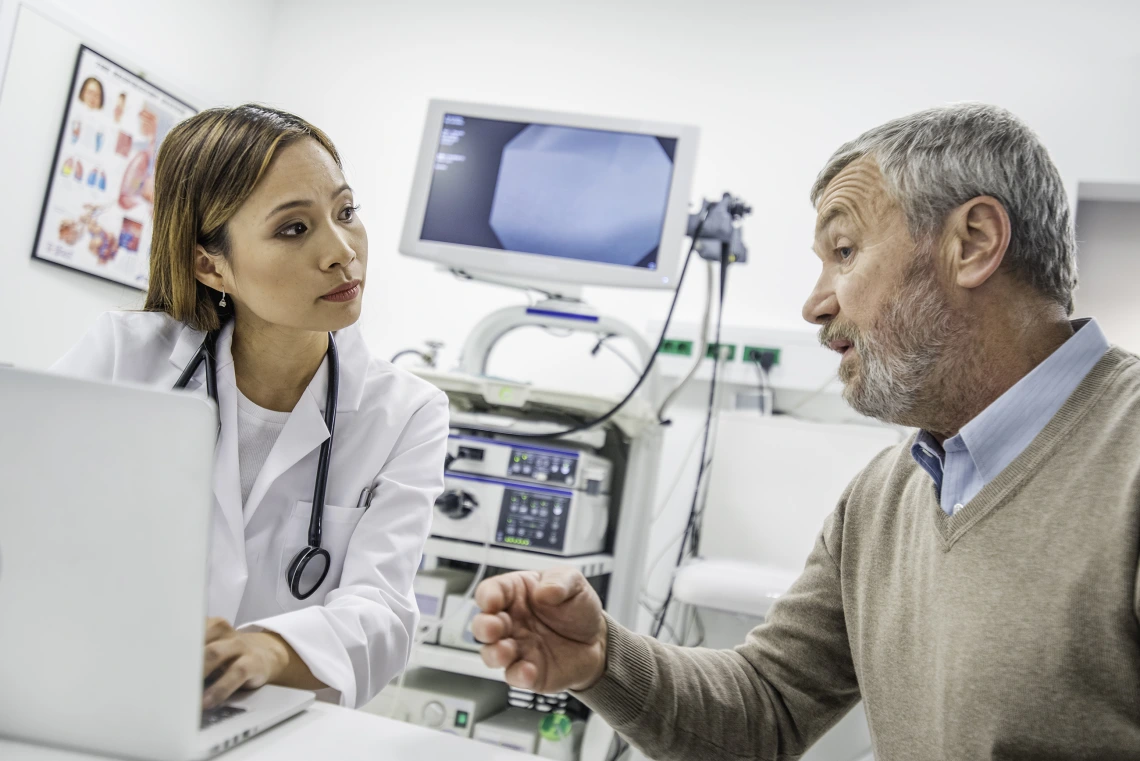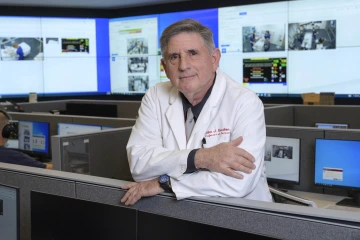New AI coaching bot may enhance medical education, training
The Arizona Simulation Technology and Education Center developed an artificial intelligence tool to train students to communicate with patients effectively and compassionately.

University of Arizona Health Sciences faculty, staff and students are developing the Artificial Intelligence Medical History Evaluation Instrument, or AIMHEI, which will use AI to help medical students learn to communicate with patients.
Researchers, staff and students at the University of Arizona Health Sciences Arizona Simulation Technology and Education Center are developing an artificial intelligence bot that they hope will revolutionize the training of medical students and health care workers.

Allan Hamilton, MD, FACS, is executive director of the Arizona Simulation Technology and Education Center at the University of Arizona Health Sciences and a Regents Professor of surgery at the UArizona College of Medicine – Tucson.
The Artificial Intelligence Medical History Evaluation Instrument, or AIMHEI (pronounced “aim high”), seeks to enhance the efficiency and effectiveness of medical communications by leveraging AI to assess student interactions with patients.
“AIMHEI represents a step big forward in our medical education, utilizing the power of artificial intelligence to coach and evaluate medical students in a way that was previously unimaginable,” said Allan Hamilton, MD, executive director of ASTEC and a Regents Professor of surgery in the UArizona College of Medicine – Tucson. “We hope it will function as the ultimate coaching tool because it not only streamlines the coaching of the medical interviewing process, but also makes it uniquely personalized for each student while saving valuable time for both faculty and students. It offers individualized coaching with targeted feedback, allowing students to refine their medical interview skills with precision.”
To evaluate a student’s medical interview, AIMHEI processes data of the exchange. Using that data, the bot produces a detailed evaluation of interpersonal skills and 16 medical content skills based on guidelines for physical exams and medical history established by the Liaison Committee on Medical Education, the American College of Surgeons and the World Health Organization.
Students receive feedback on medical interviewing “housekeeping chores,” such as how well they introduced themselves, identified the patient’s chief complaint, or reviewed family medical histories. Students also get detailed feedback on their “bedside manner,” including their ability to express empathy, maintain a polite and respectful demeanor, and adequately explain medical or technical jargon to the patient.
“Our goal is to provide the best possible opportunities for acquiring clinical expertise for our students without necessarily having to rely only on direct interface with real humans or patients,” Hamilton said. “With AI, we can calibrate the interviewing tool to the needs of our medical or nursing students, including their level of education or sophistication. It can coach them in a way that no human being could because it can be truly detailed and personalized to meet a student’s needs, and it can be utilized anytime and anywhere by that student. And, at every turn, it can provide the student with suggested examples of how to better phrase a question or put a patient at ease.”
The interviews used for pilot evaluation of the bot are drawn from an open anonymous data base and have been identified to be compliant with the Health Insurance Portability and Accountability Act, which protects patients’ personal health information, and the Family Educational Rights and Privacy Act, which protects student information. AIMHEI has been designed to ensure it remains HIPPA- and FERPA-compliant when it is used for interviewing and training by students.
Eventually, AIMHEI will be able to generate its own customized patients as an adjunct to help meet the needs for training when encounters with real patients or standardized patients might be limited, as happened during the recent COVID-19 pandemic. Standardized patients are individuals who are trained to portray patients and family members for instructional purposes.
The artificial intelligence team in ASTEC is also working on a separate method to develop machine learning capability that will evaluate students’ suturing techniques.
“One day soon, students will be able to interact with the bot directly,” Hamilton said. “Students will be able to generate an infinite variety of patients and clinical problems. It will be an invaluable resource and save our students and faculty valuable time.”
“I think AI is going to bring about the biggest change in medical education that we’ve seen in the last 100 years,” Hamilton added. “AIMHEI is an important first step for us, but we are just beginning to realize the endless potential we have to improve and transform medical education.”
The development of AIMHEI is being led by Hamilton, who has an appointment as a research professor in the UArizona College of Engineering’s Department of Electrical and Computer Engineering in addition to his position with the Department of Surgery. AIMHEI is the first project under the newly created Artificial Intelligence Division in Simulation, Education, and Training, or AIDSET, within ASTEC.
The project included the efforts of Kyle McLemore and Ricardo Martinez, coders within AIDSET, and a collaboration Winslow Burleson, PhD, a professor at the UArizona School of Information and in UArizona Health Sciences’ Health Sciences Design program and BIO5 Institute member. Undergraduate and graduate students have played a significant role in the development and testing of the tool.
AIMHEI is currently undergoing its final first-stage alpha testing with anonymous medical history interviews. Hamilton is hopeful the tool will be available for use this fall by students at the UArizona College of Medicine – Tucson.
Contact
Blair Willis
UArizona Health Sciences Office of Communications
520-419-2979, bmw23@arizona.edu

